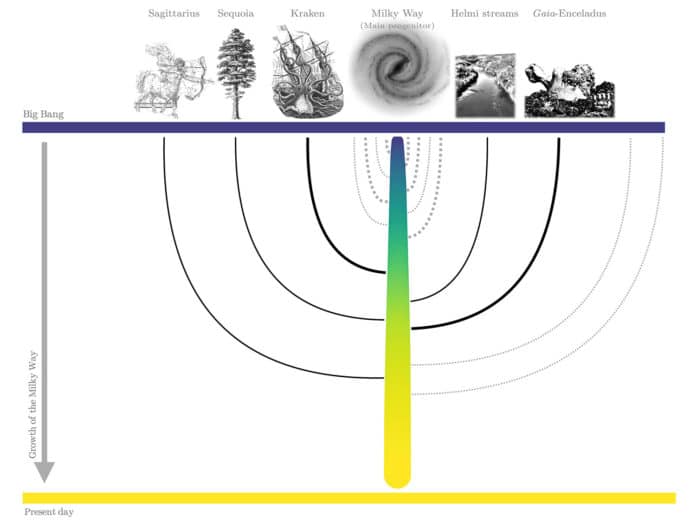Globular clusters (GCs) formed when the Milky Way experienced a phase of rapid assembly. The Milky Way hosts over 150 such clusters. Most of these clusters formed in the smaller galaxies that merged to form the galaxy that we live in today.
For decades, the old ages of globular clusters are considered ‘fossils’ to reconstruct galaxies’ early assembly histories. However, it is only with the latest models and observations that it has become possible to realize this promise.
An international team of researchers led by Dr. Diederik Kruijssen at the Center for Astronomy at the University of Heidelberg (ZAH) and Dr. Joel Pfeffer at Liverpool John Moores University has now managed to infer the Milky Way’s merger. They have successfully reconstructed the first complete family tree of our home galaxy by analyzing globular clusters’ properties orbiting the Milky Way with artificial intelligence.
Scientists achieved this by using newly developed computer simulations of the formation of Milky Way-like galaxies.
Called E-MOSAICS, the simulations include a complete model for the formation, evolution, and destruction of globular clusters.
In the simulations, the researchers were able to relate the ages, chemical compositions, and orbital motions of globular clusters to the properties of the progenitor galaxies in which they formed, more than 10 billion years ago. By applying these insights to groups of globular clusters in the Milky Way, they determined the number of stars these progenitor galaxies contained. They also got an idea when they merged into the Milky Way.
Dr. Diederik Kruijssen at the Center for Astronomy at the University of Heidelberg (ZAH) said, “The main challenge of connecting the properties of globular clusters to the merger history of their host galaxy has always been that galaxy assembly is an extremely messy process, during which the orbits of the globular clusters are completely reshuffled.”
“To make sense of the complex system that is left today, we, therefore, decided to use artificial intelligence. We trained an artificial neural network on the E-MOSAICS simulations to relate the globular cluster properties to the host galaxy merger history. We tested the algorithm tens of thousands of times on the simulations. We were amazed at how accurately it was able to reconstruct the merger histories of the simulated galaxies, using only their globular cluster populations.”
After getting these results, scientists set out to determine the merger history of the Milky Way. To do so, they used groups of globular clusters that are each thought to have formed in the same progenitor galaxy based on their orbital motion.
By applying the neural network to these groups of globular clusters, scientists could predict the stellar masses and merger times of the progenitor galaxies to high precision. It also revealed a previously unknown collision between the Milky Way and an enigmatic galaxy, named “Kraken.”
Kruijssen said, “The collision with Kraken must have been the most significant merger the Milky Way ever experienced. Before, it was thought that a collision with the Gaia-Enceladus-Sausage galaxy, which took place some 9 billion years ago, was the biggest collision event. However, the merger with Kraken took place 11 billion years ago, when the Milky Way was four times less massive. As a result, the collision with Kraken must have truly transformed what the Milky Way looked like at the time.”
Throughout its history, the Milky Way cannibalized about five galaxies with more than 100 million stars and about fifteen with at least 10 million stars. The most massive progenitor galaxies collided with the Milky Way between 6 and 11 billion years ago.
According to scientists, the study could help stimulate future studies searching the remains of these progenitor galaxies.
Journal Reference:
- J M Diederik Kruijssen et al. Kraken reveals itself – the merger history of the Milky Way reconstructed with the E-MOSAICS simulations, Monthly Notices of the Royal Astronomical Society (2020). DOI: 10.1093/mnras/staa2452
